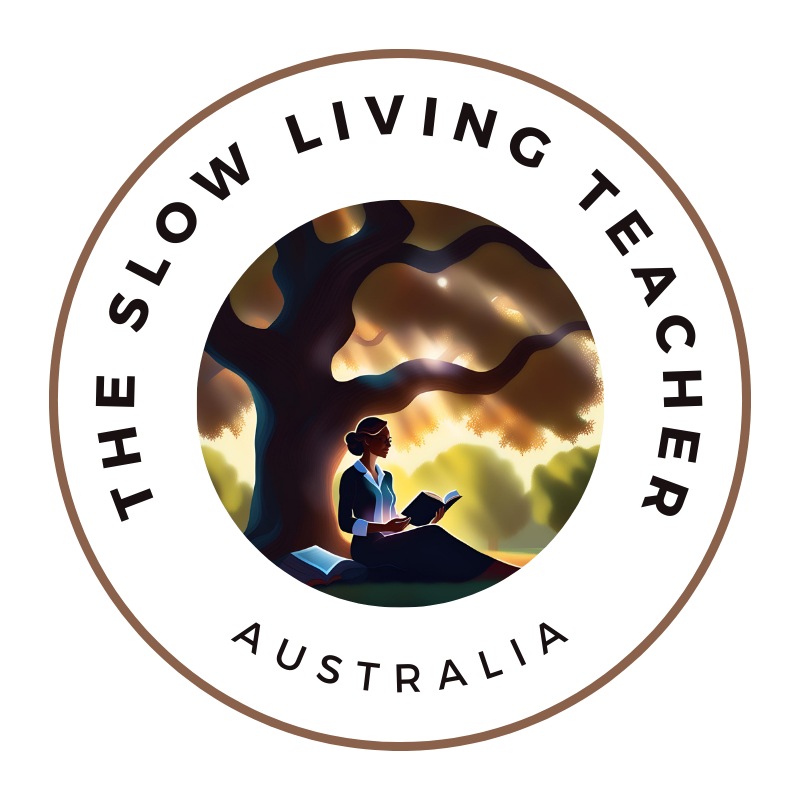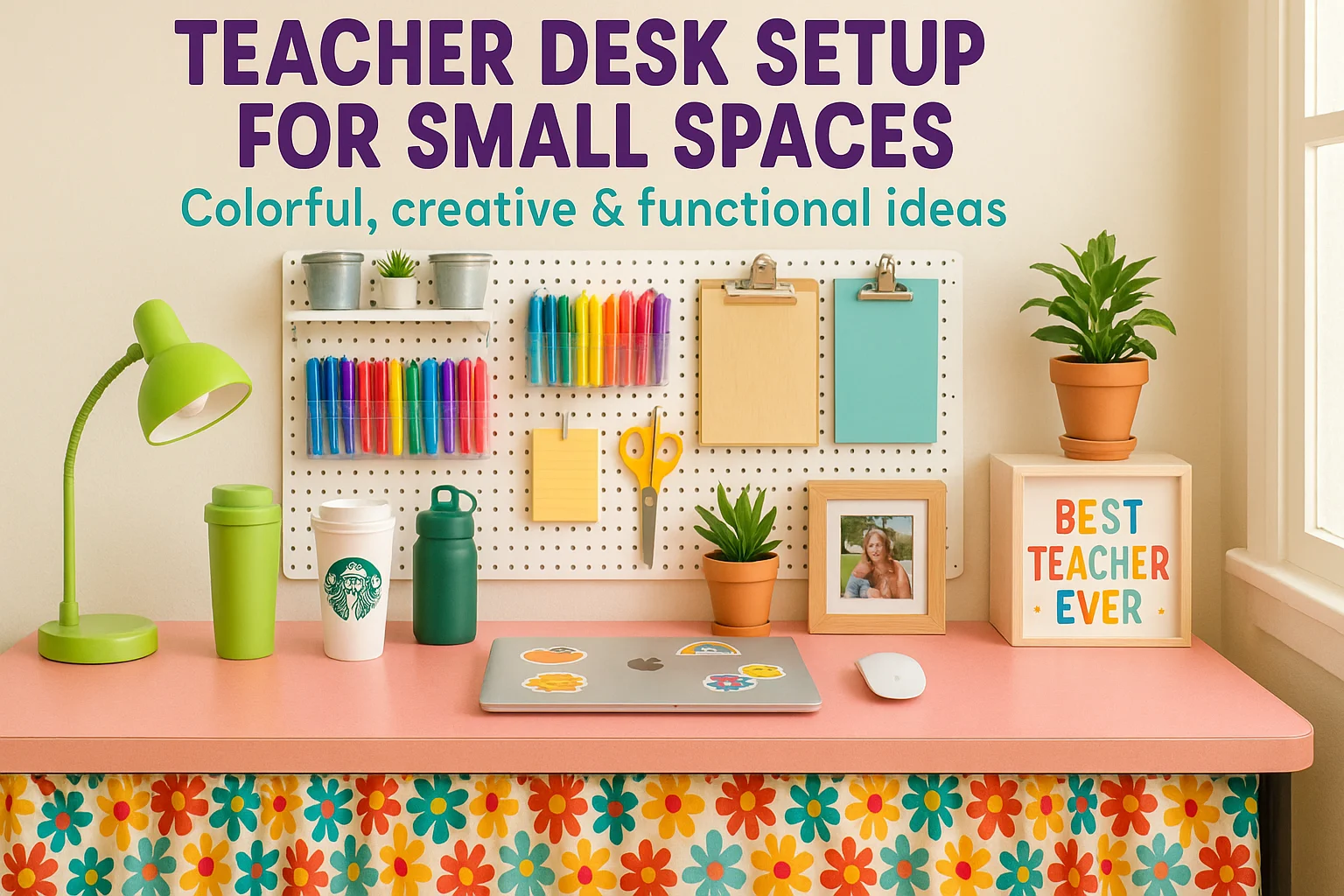Your cart is currently empty!

A Teacher’s Guide to Slow Living
Teaching doesn’t have to mean constant stress and burnout. In this post, I share 26 actionable slow living strategies that help teachers set boundaries, simplify their routines, and reclaim joy in both their work and personal lives.
This post may contain affiliate links. At no cost to you, I may earn a small commission if you click on any affiliate link within my blog.
From Overwhelmed to Peaceful
Leaving teaching has been on my mind for a while now. I’ve spent over two decades in the classroom, and while I’ve loved the work and the students, I’m ready for a change. The stress, the long hours, and the constant juggling act between work, family, and personal time have taken their toll. So I’ve put together A teacher’s guide to slow living to not only help myself but others as well.
What I’ve learned over the years is that it’s possible to leave work at work and still be a dedicated educator. It’s not about doing less; it’s about doing things differently.
I’m on a journey to find balance, to create space for slow living, and to focus on what really matters. And as much as I’m excited for what’s next, I’m also learning to be kind to myself along the way.
This blog is part of that process. It’s my way of sharing what I’ve learned with others who might be feeling the same, teachers who are looking for ways to slow down, set stronger boundaries, and find joy outside of the classroom. If you’re here, I hope you’ll find some of the tips and stories helpful as you navigate your own journey.
Recognizing the Signs of Overwhelm
If any of this sounds familiar, it’s time to consider a slower approach, one that puts your well-being first. First it’s important to recognise the signs of teacher burnout such as:
- Persistent exhaustion, even after a weekend of rest.
- Feeling irritable, detached, or emotionally drained.
- Struggling to balance work and personal life, with little time for yourself.
So here are 26 practical strategies I have tried or am going to try as I find a way to keep teaching and live slow:
1. Reframe Your Mindset: Teaching at a Sustainable Pace
Let go of perfectionism and embrace “good enough.” Slowing down doesn’t make you a less effective teacher; it allows you to show up fully for yourself and your students. Teaching at a relentless pace can lead to burnout and diminished effectiveness. Reframing your mindset allows you to focus on what’s essential and approach your work with balance and sustainability.
You don’t need to do everything at once to make a difference. By teaching at a sustainable pace, you create space for energy, creativity, and long-term impact. Perfection isn’t sustainable; progress is.
Try This:
- End your workday with a simple reflection: “What went well today?”
- Stop trying to reinvent the wheel and use lesson plans that work.
- Focus on one or two major goals per term instead of trying to achieve everything at once.
- Give yourself permission to take breaks during the day, even 5 minutes of mindfulness can help.
2. Let Go of the Non-Essentials
Simplifying your responsibilities creates space for what brings you joy. And carrying the weight of non-essential tasks distracts from meaningful teaching and drains your energy. Letting go of what’s not necessary allows you to focus on impactful work.
It’s okay to let some things go. Letting go creates more time for creativity and connection. The quality of your teaching is not defined by doing everything. It’s about doing what matters most.
Try This:
- Identify one task to stop doing this week.
- Ask yourself: “Will this matter a year from now?” If not, let it go.
- Use templates for repetitive tasks like lesson plans or parent communication.
- Politely decline extra commitments that don’t align with your goals.
3. Anchor Your Day with Intentional Transitions
Intentional transitions between activities help ground you, reduce stress, and improve focus. They create a sense of rhythm in your day. So creating rituals to shift between work and home life helps you mentally and emotionally reset.
A few mindful moments during transitions can set the tone for the next part of your day. It’s a simple way to bring calm and clarity. Transitions are opportunities to reclaim your energy. So even small rituals create big mental shifts.
Try This:
- Take three deep breaths before entering the classroom in the morning.
- Pause to sip a cup of tea or coffee before starting your next task.
- Change into comfortable clothes as soon as you get home.
- Light a candle or make a cup of tea to signify the end of your workday.
4. Align with the Seasons of Teaching
Teaching has natural ebbs and flows. Aligning with these seasons helps you adjust your pace, priorities, and energy levels to avoid burnout.
Each term brings its own challenges and opportunities. Recognize that some seasons require more effort while others allow for rest. Embracing these rhythms helps you stay balanced and effective.
Try This:
- Use holidays for reflection and rest!
- During peak times, simplify your routines.
- Create seasonal goals that align with the academic calendar.
- During busy times (e.g., exams), simplify other areas of your life.
- Use quieter periods to reflect, plan, or try new ideas in your teaching.
5. Practice Slower Communication
Thoughtful communication encourages better relationships and reduces misunderstandings. Slowing your communicatio down also allows you to connect more meaningfully with students and colleagues.
You don’t have to respond immediately to be effective. Thoughtful, intentional communication can often achieve more. So it often helps to pause before you respond as clarity comes from calm. On another note, listening fully makes others feel valued.
Try This:
- Wait 24 hours before responding to non-urgent emails.
- Use phrases like, “Let me take some time to think about that.”
- Practice active listening by giving your full attention during conversations.
- Use simple, clear language when giving instructions to students.
6. Celebrate Your Wins, No Matter the Size
Recognizing even the smallest victories helps build a positive mindset and keeps you motivated. Celebrating wins reminds you of the progress you’re making.
Every win, no matter how small, is worth celebrating. You’re doing more than you realize, and those moments deserve to be acknowledged
Try This:
- Write down three wins every Friday.
- Treat yourself to a small luxury, like a special cup of tea.
- Share your wins with a trusted friend or colleague.

7. Embrace the Art of Saying “Not Yet”
Saying “not yet” allows you to focus on what’s most important now while leaving room for future possibilities. It helps you avoid overcommitting and protects your energy. Delaying non-essential tasks creates space to focus on what’s really important right now.
You don’t have to do everything right now. By saying “not yet,” you’re giving yourself permission to prioritize and pace yourself. “Not yet” is a powerful boundary.
Try This:
- Create a “Not Yet” list for tasks that can wait.
- Use this phrase in emails: “I’ll revisit this after [specific timeframe].”
- When asked to take on a new task, respond with, “Let me think about it,” before committing.
- Practice saying “not yet” to yourself when you feel tempted to take on too much.
8. Curate a “Calm Corner” in Your Classroom
A peaceful space promotes focus and relaxation for both you and your students.
Everyone needs a moment of calm during the day. A dedicated space for this can make a big difference in how you and your students feel and function.
Try This:
- Add a small plant, lamp, or soft textures to a space in your room.
- Stock up on mindfulness tools like stress balls, calming cards, or journals.
- Use a calm corner for quiet reflection during breaks or after challenging moments.

9. Connect with Nature During the Day
Nature has a calming, restorative effect that can improve mood, reduce stress, and increase focus. Even a few moments outdoors can make a difference.
Fresh air boosts creativity and clarity. Stepping outside, even briefly, is a simple way to reset your mind and body. Nature offers a natural antidote to stress. It reminds us to slow down and appreciate the present moment.
Try This:
- Take your lunch outside or near a window.
- Bring a nature-inspired element (e.g., flowers or leaves) into your classroom.
- Spend a few minutes observing the sky, trees, or flowers on your way to class.
- Open the windows in your classroom to let in fresh air and natural light.

10. Practice One Intentional Act of Kindness Daily
Acts of kindness create positive ripple effects, improving both your mood and the environment around you. Small gestures can make a big impact on your day.
Kindness doesn’t require extra time or effort. It’s about choosing to make someone’s day a little brighter, which often brightens yours as well.
Try This:
- Compliment someone sincerely.
- Leave a note of encouragement for someone who might need it.
- Offer to help with a small task, like holding the door or sharing a resource.
11. Embrace “The Power Hour” for Slow Productivity
A dedicated power hour helps you focus on one or two key tasks without distractions. It’s a way to work efficiently while avoiding the stress of multitasking.
Productivity doesn’t have to mean hustling all day. A focused hour of intentional work can be more effective than hours of scattered effort.
Try This:
- Set a timer for one hour to work on a single task.
- Turn off notifications and distractions during this time.
- Choose one high-priority task to tackle during your power hour.
- Use this time to work on something that aligns with your long-term goals.

12. The Joy of Unplugged Evenings
Unplugging from screens in the evening allows your mind to rest and creates space for meaningful, restorative activities. It also improves sleep quality and overall well-being.
Your mind deserves rest. And true rest replenishes your energy for tomorrow. So an unplugged evening is a gift to yourself. It’s a chance to slow down, connect with loved ones, or simply enjoy some quiet time.
Try This:
- Create a “no screens” rule after a certain evening time.
- Use the evening to connect with family or friends over
- Use analog tools (like a planner).
- Spend time reading, journaling, or enjoying a creative hobby.

13. Rediscover Play and Creativity Outside of Work
Engaging in playful or creative activities nurtures your inner joy and balances the intensity of teaching. It reminds you of the joy of learning and exploration. It rejuvenates your spirit and provides a refreshing contrast to work.
Life is more than responsibilities. Play and creativity are essential for your well-being and happiness, not just for your students’. Playfulness unlocks joy and curiosity. And so creativity provides a healthy outlet for stress and prioritizing fun helps you reconnect with yourself.
Try This:
- Take up a new hobby like painting, knitting, or baking.
- Dedicate an hour a week to a playful activity with friends or family.
- Join a local class or workshop to explore something new.
- Join a local sports or game group to reconnect with fun.
- Explore playful activities with your family, like puzzles or building forts.

14. Lean Into Slow Weekends
Weekends are a chance to recharge, but often we fill them with to-do lists and errands that leave us feeling more drained. Embracing slow weekends is a way to unwind and nourish your body and mind, allowing you to enter the new week with energy and intention.
Taking time to slow down isn’t wasted time. It’s a form of self-care that impacts not just your weekend, but your entire week. You deserve time to rest, enjoy life’s little pleasures, and reconnect with what brings you joy.
Try This:
- Spend Saturday morning having a leisurely breakfast, free from distractions.
- Set aside Sunday afternoons for a quiet walk in nature or time spent with a hobby that brings you peace.
- Practice saying “no” to obligations that don’t serve your well-being.

15. Adopt a Minimalist Approach to Lesson Planning
A minimalist approach to lesson planning can reduce overwhelm and help you focus on what truly matters for your students’ learning. When you simplify your plans, you can be more present and intentional with your teaching, without feeling like you need to constantly reinvent the wheel.
You don’t need elaborate lessons every day to make an impact. Sometimes, the simplest ideas are the most effective. Give yourself permission to focus on quality, not quantity.
Try This:
- Plan one core concept for the week and build around it with a few key activities.
- Use tools like templates or pre-made resources to save time without sacrificing learning outcomes.
- Allow for flexibility in your lessons to make room for real-time learning moments.
16. Time-Block for Rest
Rest isn’t a luxury; it’s a necessity for productivity, focus, and long-term health. Time-blocking for rest helps prioritize downtime in your schedule, ensuring you’re not running on empty.
Rest is a form of self-respect. By scheduling it like any other important task, you remind yourself that you are worthy of time to relax and recharge.
Try This:
- Schedule 30 minutes a day to unwind without screens: read a book, meditate, or my personal favourite – take a nap.
- Block out one day per week to be completely free from work-related tasks.
- Use a timer to create clear boundaries for work and rest during the day.
17. Ritualize Your Commute
Commuting can often feel like wasted time, but it can also be an opportunity to establish a mindful routine. Turning your commute into a ritual helps you transition from work to home mode, setting the tone for the rest of your day.
Even in the busiest moments, you can create pockets of peace. A simple commute ritual can signal to your brain that it’s time to slow down and reflect, which leads to a more grounded approach to life.
Try This:
- Use the drive or train ride to listen to an audiobook, podcast, or calming music.
- Practice deep breathing or mindfulness during your commute to reset your energy.
- Plan your commute with time to stop and grab a favorite coffee or enjoy a peaceful moment before you get home.
18. Practice the “One-Task Rule”
Multitasking can be counterproductive and exhausting. The “one-task rule” encourages you to focus on a single task at a time, allowing you to finish work faster and with better results, while also giving yourself permission to disconnect once the task is complete.
When you focus on one thing at a time, you work more efficiently and with greater attention to detail. There’s no need to rush through multiple things at once.
Try This:
- Set a timer for 25 minutes and commit to focusing on one task during that time (like grading or writing).
- Put away distractions like your phone or unrelated tabs during focused work sessions.
- Celebrate completing one task fully before moving on to the next.
19. The Sunday Reset
A Sunday reset helps you ease into the week ahead by preparing your environment, mindset, and schedule. It’s a simple way to reduce anxiety about the upcoming week and ensure that you start Monday with a clear head and positive outlook.
A little preparation goes a long way. Taking an hour or two to organize your space or reflect on the week ahead helps you enter the workweek with confidence.
Try This:
- Tidy your desk or workspace to create a clean slate for the week ahead.
- Plan your meals or groceries for the week to reduce stress during the workday.
- Reflect on the past week and set simple intentions for the upcoming one.

20. Declutter Your Teaching Life
Teaching can come with a lot of physical and mental clutter such as papers, notes, lesson plans, grading, and expectations. Decluttering allows you to focus on what matters, freeing up your time and energy for more meaningful work and personal relaxation.
Decluttering isn’t just about tidying up; it’s about creating space for clarity and creativity. By removing what doesn’t serve you, you make room for what helps you thrive.
Try This:
- Organize your desk or classroom by sorting through piles of papers and resources you no longer use.
- Digitize your lesson plans and notes to reduce paper clutter.
- Let go of outdated teaching practices that no longer align with your values or goals.
21. Slow Grading Practices
Grading doesn’t have to be rushed or stressful. Slowing down your grading process not only ensures higher-quality feedback for your students but also creates more balance in your work-life dynamic.
Quality feedback is far more valuable than a quick grade. Taking time to thoughtfully assess student work and provide constructive comments helps both you and your students grow.
Try This:
- Grade in batches, focusing on one assignment or student at a time, without rushing through them all in one sitting.
- Set aside specific, uninterrupted blocks of time for grading to reduce the stress of multitasking.
- Use rubrics and clear criteria to make grading faster and more focused.
22. Embrace Silence in the Classroom
Silence is a powerful tool in the classroom. It helps students focus, reflect, and calm down. As a teacher, embracing silence can also give you space to recharge and think clearly during class.
Silence doesn’t mean disengagement; it can foster creativity and thoughtfulness. A quiet classroom allows for deeper connections and greater attention to the task at hand.
Try This:
- Use “silent moments” at the beginning of class for students to settle in and focus.
- Incorporate silent work periods where students can concentrate on tasks without interruptions.
- Try a few minutes of silence at the end of class for students to reflect on what they’ve learned.
23. Integrate Thrifted Finds into Your Workspace
Thrifted items bring character, warmth, and personal meaning into your workspace. They’re an affordable way to create an inspiring, unique environment that encourages creativity and slow living.
Your workspace should feel like a reflection of your personality. Thrifted finds add soul and history to your surroundings, creating a more inviting, grounded atmosphere.
Try This:
- Decorate your desk with a vintage lamp, a unique vase, or old-school stationery.
- Use thrifted frames for class photos or motivational quotes.
- Find a second-hand bookshelf or filing cabinet to organize your materials in style.

24. Redefine Productivity with “Enough” Days
We often chase the idea of being “productive” all day long, but this can lead to burnout and overwhelm. Redefining productivity with “enough” days means recognizing that accomplishing what you can without pushing yourself beyond your limits is still a success.
Sometimes, “enough” is more than enough. When you embrace this mindset, you focus on completing what matters most, leaving room for rest and recovery.
Try This:
- Set a realistic goal for your day and stop when you’ve accomplished it, even if you feel you could do more.
- At the end of the day, ask yourself what you’ve done well, rather than focusing on what’s left undone.
- Create a “done” list to remind yourself of what you’ve already achieved.
25. Savor Small Moments of Joy
We often wait for big events to bring us joy, but happiness is found in the small, everyday moments. By consciously savoring these moments, you can cultivate a sense of gratitude and contentment.
Small moments of joy can make all the difference. Whether it’s your morning coffee or a quiet minute in the classroom, these fleeting experiences can provide a deep sense of fulfillment.
Try This:
- Take a moment to appreciate the beauty of a sunrise or sunset.
- Slow down and enjoy a delicious cup of tea or coffee without distractions.
- Savor a quiet moment with your students, focusing on their engagement and progress.
26. Break Free from the “Busy Teacher Badge”
Being busy doesn’t mean you’re effective or successful. The “busy teacher badge” is a badge of honor that often leads to burnout. It’s important to break free from this mindset and recognize that doing less, with more intention, can be more impactful.
You don’t need to be constantly busy to be a great teacher. Prioritize your well-being and set boundaries that allow you to be effective without the pressure of always being “on.”
Try This:
- Set strict work hours and stick to them, leaving work at work.
- Identify tasks that can be delegated or streamlined to free up your time.
- Practice saying “no” to commitments that drain your energy or don’t align with your values.
Final Thoughts
As teachers, we often give so much of ourselves to others that it can feel impossible to prioritize our own needs. But the truth is, embracing slow living doesn’t make you a less dedicated educator – it makes you a more balanced, fulfilled one. Each of these tips is a small step toward reclaiming your time and energy, helping you show up as your best self, both inside and outside the classroom.
I’ve been where you are, feeling pulled in a million directions and unsure how to slow down. But with intentional choices, I’ve learned to create space for the things that make me happy. You can, too. Start small, try what resonates with you, and give yourself grace along the way. You deserve a life that feels manageable, joyful, and aligned with your values. Let’s take this journey together, one step at a time.




